As an on-again-off-again student of Indian history, what struck me immediately about Epic's Unreal 5 demo, Lumen in the Land of Nanite, were the strong architectural cues the demo appeared to draw from early and medieval Indian architecture, specifically the 5th century monastery complexes at Ellora and Ajanta.
Considering the breadth of India's 5000 year-old history, it's a surprisingly underused setting for videogames: the cities of Rakhigarhi, Harappa, and Mohenjo Daro were the largest in the Bronze Age world, with straight roads, urban planning, and indoor plumbing at a time when Stonehenge was just being erected in England. So many empires, republics, and petty kingdoms have risen and fallen over the years that everything from Dishonored to Assassin's Creed to fantasy MMOs could find their home here.
The relatively small homegrown gaming audience is one reason for India's gaming obscurity. In contrast, the sheer number of Chinese PC gamers has meant that everyone from Creative Assembly to Ubisoft has explored Chinese historical themes in recent games. But another possible reason is less obvious: architecture and rendering complexity.
Monumental architecture in more popular locales like AC: Origins' Ptolemaic Egypt is big, bold, and, crucially, easy to render. The Great Pyramid of Giza has four massive sides and, well, that's about it. Even the statues dotting AC: Odyssey's Greek islands are rough-hewn approximations. Indian architecture, and specifically, South Indian Dravidian temple architecture, is a whole different matter.
Indian temples tell stories, and not just metaphorically. Tens of thousands of individual sculptures, narrating legends and capturing snippets of day-to-day life are carved into gopuras, the gate-pyramids that front South Indian temples. The 11th century Madurai Meenakshi temple complex is breathtaking, with countless sculptures painted in vivid shades. For developers, though, rendering it, or even a small part of it, would pose an incredible challenge compared to rendering the smooth surfaces of the Great Pyramid, or even the Gothic arches of Notre Dame. When just a single sculpture needs 10K polys, how on earth do you build a literal pyramid out of sculptures?
Uncharted: Lost Legacy tried to do this in 2017, but its sparse Hoysala temple approximations are almost laughable in comparison to what Epic achieved in the Lumen in the Land of Nanite tech demo. Age of Empires II does better, though it uses sprites to get the job done.
Unreal 5's Nanite micro-polygon rendering system appears to have given us the answer. To wit, Nanite is an imagined space: this isn't early medieval India. However, the architecture shown appears to blend Mesoamerican motifs with intricate, trabeated structures and domes that draw heavily from Indian architectural traditions.
Towards the end of the demo, the camera pans over a massive complex of rock-hewn structures that bring the Ajanta and Ellora caves to mind. Ajanta and Ellora are home to some of the world's largest rock-hewn buildings. Multi-story Hindu, Jain, and Buddhist monasteries, dating back to the 5th century AD, were carved out of sheer granite into intricate, artificial caves.
According to Epic, Nanite makes REYES (Render Everything Your Eyes See) possible, with triangle counts scaling to a per-pixel level.
What this means is that the image onscreen displays as much polygonal complexity as the screen's pixel count allows: incredible detail up close and no perceivable loss in fidelity at farther distances. During one particular scene in the demo, it cut from a closeup of a single statue made up of over 30 million polygons to a room containing 500 of them without a performance drop, on what appears to be PlayStation 5 hardware.
While there's no indication that ninth-gen games set in medieval India are currently in development, Nanite at least makes this technically feasible. And when it comes to "next-gen," that's what really matters: what can the PlayStation 5 and Xbox Series X do that the PS4 and Xbox One cannot? Ray-tracing, 4K/60 gameplay and now, perhaps, an accurate representation of Indian architecture.
























